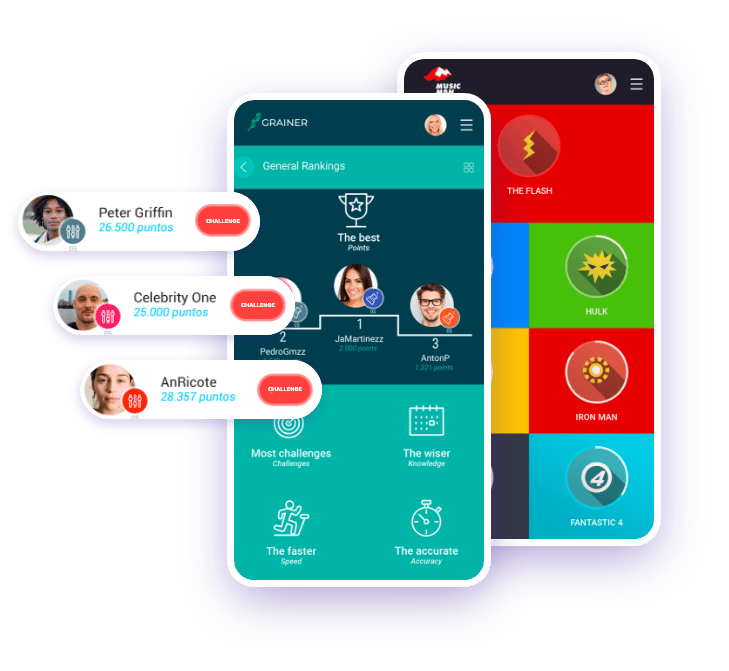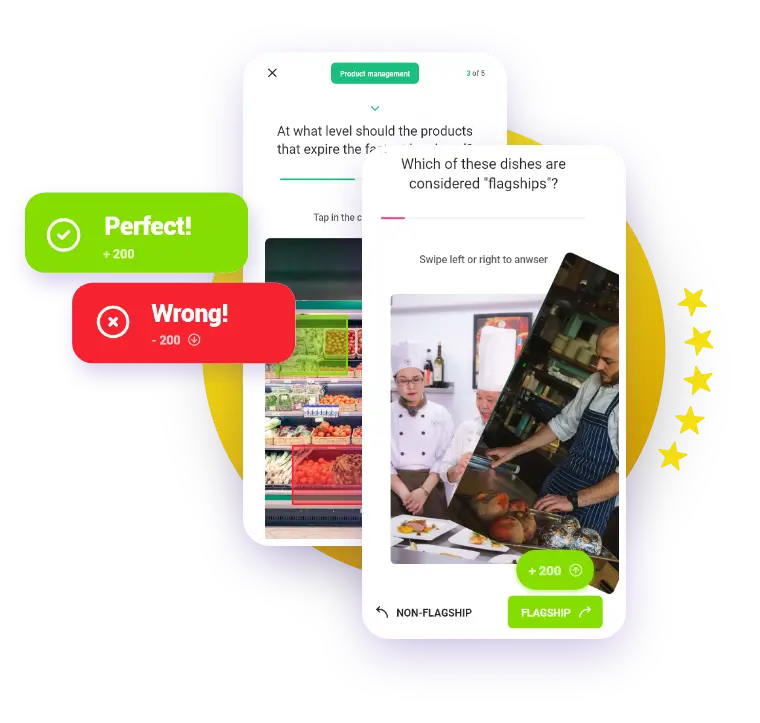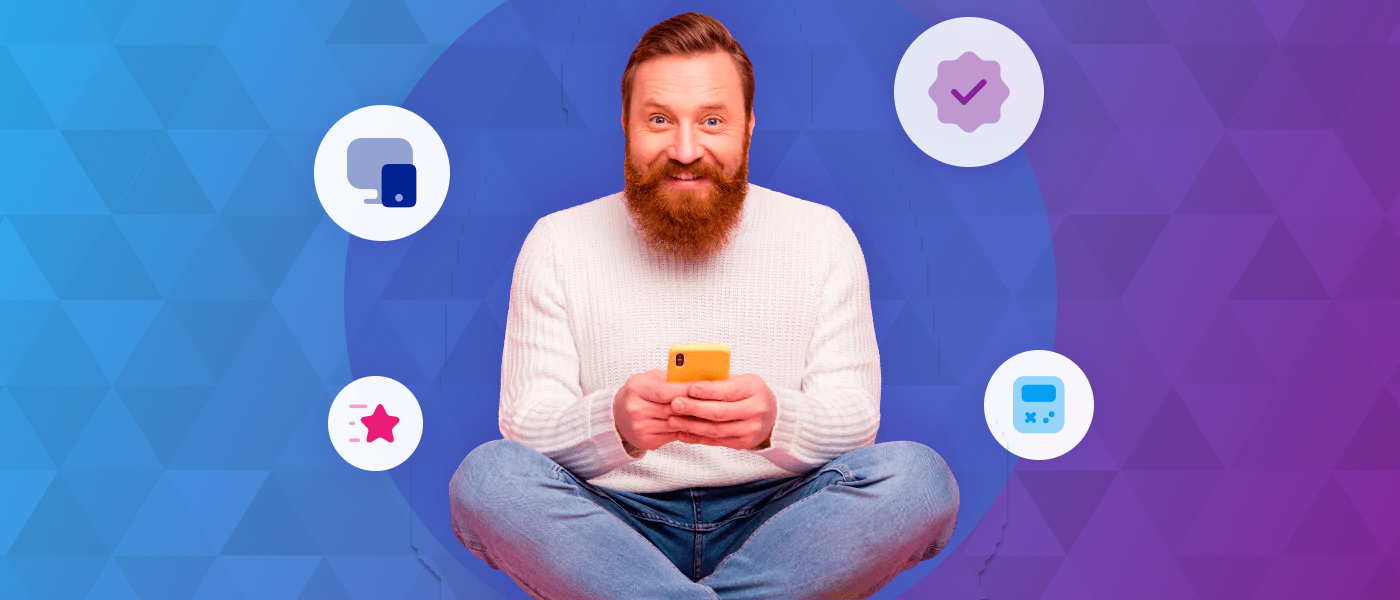[ad_1]
Gamification is a strategy that has revolutionized the world of e-learning by cleverly fusing game elements with the educational process. This approach aims to transform learning into a fun experience that dramatically increases student engagement, motivation, and participation.
Although there are many other initiatives and learning activities that attempt to make learning a more attractive, effective process, gamification succeeds because it appeals to specific human instincts. These include the desire to compete, recognition for achievement, and the experience of rewards and fun. It’s this appeal to instinct that makes the strategy so effective.
However, if you’re looking to awaken these instincts and bring about meaningful change in employee behavior, then you’ll need to understand the fundamental characteristics of gamification. Below, we walk you through these, and explain how specific gamification features appeal to users.
What are the most important gamification features?
When we implement a gamification strategy for business purposes, the main purpose is to foster higher levels of motivation for the learning process among employees. This, in turn, will result in a faster, more effective uptake of new skills and competencies. In fact, integrating game mechanics into learning programs has been shown to increase participation by up to 60%. However, in order to achieve a level of success like this, it’s important to integrate a number of key features. These include:
1. Friendly competition that encourages participation
Competition is a fundamental, ever-present element within a gamification strategy. It is part of their basic dynamics, and a key component in driving participation and commitment. However, in order to ensure that learning is effective, it’s crucial that this competition has a healthy, positive and encouraging framework, rather than being intimidating or exclusionary.
A good example of this is group competitions, where each participant earns points individually to level up their own position, or compete with other players. This concept can even be taken further to include competitions between teams or departments, where each member plays their part to achieve a wider goal, encouraging participation and teamwork. Remember to keep it friendly!
2. Motivational rewards to drive achievement
Within any good gamification strategy, elements such as points, badges, and leaderboards play a key role, motivating users to engage with learning. A learner is more likely to complete assigned modules, or log into their learning platform more frequently, if they can use these tasks to earn additional points or badges which move them up a leaderboard. The important thing here is that these rewards should recognize the achievements of users, but not shame them for any failed attempts.
For example, by completing a professional development course, employees could earn points that place them higher on an internal leaderboard. In addition, upon reaching a specific milestone, they could then receive a special badge in recognition of their achievements – thereby motivating them to continue further.

3. Customization to personalize the gaming experience
Often, when we talk about personalization, we tend to think only about offering content that is tailored to each user’s individual preferences. However, in gamification, customization goes one step further, creating a whole learning experience that adapts to the skill level, learning style, and specific objectives of the user in question.
So, keep in mind that your gamified training should adapt to the level of knowledge of your students, and provide activities especially designed to address those areas that need more attention.
For example, imagine that you plan to offer your employees a digital marketing course, but where each one receives a personalized study plan based on their level of previous experience, knowledge, and professional goals. Those with a more basic knowledge could start with simple modules to explore fundamental concepts, while more advanced students could immediately access specialized modules, covering complex social media advertising strategies or data analysis. This type of personalization ensures that each student makes the most of their learning time, and acquires the specific skills they need to achieve success in marketing.
4. Progression and ‘unlocks’ that keep users interested
Another essential gamification feature is progression. The feeling of making progress, as well as the possibility of unlocking new levels or rewards, are key elements in maintaining interest and motivation in the long term.
Gamification works on the same principles that power video games. When we play games, we feel that we have ownership over something, which we want to improve, protect and get something useful out of. But in order to develop this sense of belonging, it’s crucial that the recognitions and rewards that come from gameplay are meaningful.
This can be achieved through offering custom badges or special privileges as rewards, or giving employees the chance to unlock exclusive content when they hit a certain score. Creating a level-based structure heightens engagement and intensifies the desire to improve, since students feel that they are moving measurably towards their final goal, each achievement bringing them one step closer to it.

5. Consistent feedback to drive continuous improvement
When it comes to learning, consistent feedback is essential for students to understand their progress and improve accordingly. In addition to correcting basic errors, this approach also helps to increase each student’s awareness of their own level of learning.
Gamification provides an ideal platform for consistent feedback, allowing students to easily perceive their level of knowledge, and observe which areas they excel in as well as those which need some improvement. On the other hand, it also allows leaders to evaluate the skills and abilities of their employees, providing valuable information to assist with talent management and development.
Consider the following example of good feedback. In an online course on computer systems, students must confront a series of interactive problem-solving simulations. After performing each diagnostic task, the student receives an immediate response from the system on the effectiveness of their actions. If they make a mistake, the system can pinpoint exactly what it is, as well as suggest alternative solutions.

6. An engaging narrative to create immersion
Gamification uses narrative to forge an emotional connection with users. Through stories, characters and environments, they offer a means to identify and empathize with the learning experience.
This results in a more engaging, immersive and exciting experience, which keeps students more engaged throughout the course. For example, a gamification platform can present learning concepts as if they were part of an adventure, where students need to assume the role of heroes in order to complete a mission. Learning might also take the form of a treasure hunt, where each clue is a concept that helps them to develop broader knowledge.
7. A striking visual design that generates engagement
Visual design plays an important role in gamification, by creating an engaging and aesthetically pleasing experience. Elements such as avatars, levels, points and medals not only structure the activity that takes place within a game, but also produce sensations and experiences within a player. Therefore, your aesthetic should integrate colors, shapes and animations that are attractive and can be connected with the organization.
A well-thought-out design also influences usability and user experience, which is why it should feature high-quality multimedia elements, and come with an intuitive interface that allows fluid navigation from any device.
For example, imagine a training course on the policies and procedures of a global organization. Its visual design should reflect the company’s identity, featuring corporate colors and graphical elements consistent with the brand. Within the course, participants can be guided through different levels of learning – represented visually as steps – with high-quality animations and videos that explain each concept in a clear and dynamic way.

8. Social collaboration, teamwork and community
Finally, a gamified training program should provide tools that promote social interaction, such as team challenges, leaderboards, and even real-time communication features like chats or forums.
The social and collaborative areas of your gamification tool should invite employees to form a community where the exchange of ideas, participation and collaboration is freely promoted.
For example, team members could collaborate to solve a specific learning problem, sharing their experiences and knowledge to create effective solutions. This collaboration will not only strengthen employees’ leadership skills, but also help them to form an enriching environment of collaborative learning.
What features should the best gamified app for business training have?
To guarantee success in your gamification strategy and improve user experience, it’s essential to choose the right tool – one that provides you with a comprehensive, easy-to-implement solution, and features an intuitive, friendly design adapted to all levels of experience. Below, we share the key features you should be looking for when choosing your ideal gamification app:
The essential advantage of a gamification app for business training is its ability to transform learning into a fun and motivating experience. This involves utilizing elements such as levels, challenges and immersive narratives designed to keep employees engaged and hooked on the training.
In order to achieve this, your gamification app should encompass a wide variety of games and exercises that respond to the specific training needs of your employees. Be sure to include quizzes, question-and-answer, fill-in, complete, or match exercises, and any other elements that transform the learning content into simple, fun activities.

As we’ve seen, rewards and prizes are essential elements in any gamification strategy. As team members complete missions, progressing through levels and learning in the process, it’s important that they encounter tangible incentives that reinforce the specific behavior you wish to encourage. These should continue to motivate them to achieve their learning objectives.
The ideal gamification app should offer you the opportunity to integrate a meaningful and relevant reward system for employees. This may include virtual badges, or points that can later be redeemed in exchange for privileges, access to content or rewards.
The data analysis function of a gamification app is essential if you want to evaluate the effectiveness of your training. These types of features allow you to chart the progress of employees, and make adjustments to your program in real time.
Additionally, a good gamification app should also collect data on parameters like performance, time spent on learning activities, areas of greatest interest, common difficulties, and level of completion. With this data in hand, leaders can identify trends, areas for improvement, and personalize the whole learning experience for each individual. Moreover, these metrics can also provide valuable insights into return on investment in training, helping you to plan and justify resource allocation, as well as demonstrate the added value of gamification in the workplace.

-
Social and collaborative area
Finally, learning is an activity that is enriched through the open exchange of knowledge and collaboration with others. Therefore, a good gamification app should offer your employees the opportunity to share, comment, consult and discuss within a dedicated social environment, as this encourages collaborative interaction between employees.
When choosing your ideal app, make sure it offers a space that facilitates communication, debate and teamwork. This can include areas such as discussion forums, live chat rooms, and resource-sharing spaces with features that allow users to interact, react or comment. It should also feature notifications, to keep employees updated on new documentation, challenges overcome by colleagues or the wider team, and more.
Transform your training into a fun and unique experience with isEazy Game
Now you know which gamification features the ideal app should have for training your team, it’s time for you to discover isEazy Game – the market’s best gamification app, perfect for engaging and motivating your employees.
Boost your team’s learning – while they have fun doing it -through a platform that brings together gamification, social dynamics and a collaborative environment all in one place. With isEazy Game, you can easily transform any training content into a game or challenge that will multiply the results of your training x10.
It’s so simple! Just choose your favorite format to create individual or team games, finish it up with content including audio, video or images, and finally personalize it by adapting it to your corporate branding. And the best part? Keep an eye on the progress of your employees, and identify what content connects best with each one through a comprehensive dashboard. Its various metrics will help you gauge the impact of training intuitively and effectively. So, request a demo today, and start enjoying the gamification app that your team won’t be able to put down!
[ad_2]

